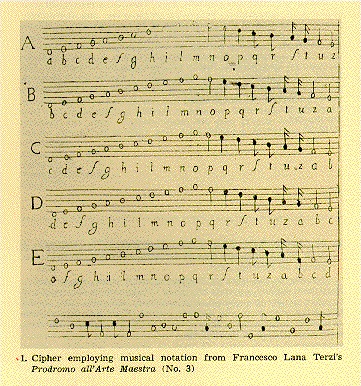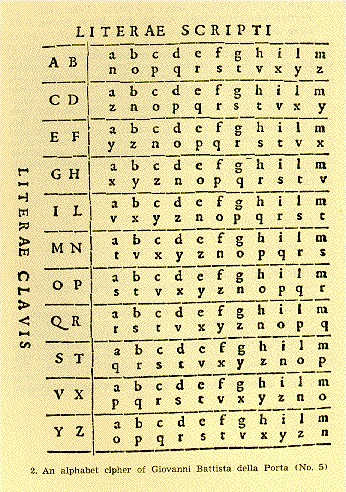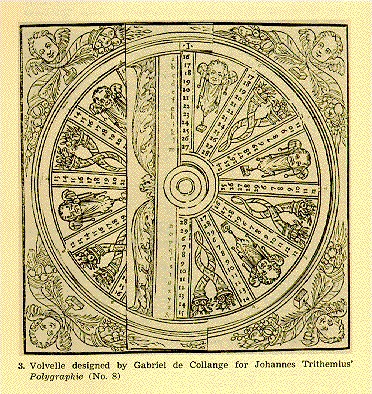Cryptography
JOHN FALCONER (fl. 1685-1692)
Cryptomenysis Patefacta; or, The Art of Secret Information Disclosed without a Key.
London, Daniel Brown, 1685.
John Falconer was a distant relative of David Hume's family, and a supporter of King James II. Held in high regard by Philip Thicknesse (1719-1792), the works of Falconer on secret writing and the conveying of concealed messages include Cryptomenysis Patefacta and Rules for Explaning and Decyphering all Manner of Secret Writing (London, 1692). Of special interest in Cryptomenysis is a section on semeiology, which Falconer defines as "methods of secret information by signs and gestures." Among such signs and gestures Falconer includes Egyptian heiroglyphs and finger alphabets (dactylology). A brief analysis of selected writings of Johannes Trithemius (1462-1516) concludes the work. Cryptomenysis has been greatly influenced by Gaspar Schott (1608-1666) and John Wilkins, Bishop of Chester (1614-1672). (Alston III (2): 787; Galland p. 62; Westby-Gibson p. 64; Wing F296)
ATHANASIUS KIRCHER (1601-1680)
Polygraphia Nova et Vniversalis ex Combinatoria Arte Detecta.
Rome, Varese, 1663.
This work of the German scholar and mathematician is based principally on the writings of Johannes Trithemius. Joaquín García Carmona and others see also the influence of Blaise de Vigenère (1523-1596), whose multi-alphabet cipher seems to have been transformed by Kircher into a numerical cipher. Of special interest inPolygraphia is part 1, where Kircher proposes a system of pasigraphy, or universal writing, employing numerals to stand for words of similar meaning in Latin, Italian, French, German, and Spanish. Parts 2 and 3 deal with cryptographic methods now largely abandoned. (Galland p. 102-103; Guyot p. 426; Stojan 35; Westby-Gibson p.105)
FRANCESCO LANA TERZI (1631-1687)
Prodromo all'Arte Maestra.
Brescia, Rizzardi, 1670.
Italian naturalist and physicist, Lana Terzi deals principally with problems of aeronautics, mechanical engineering, and microscopy, including a section on the construction of flying machines. Of special note are the opening sections, wherein alphabet and numerical ciphers are described. Prodomo includes an early illustrated description of a cipher employing musical notation, a method initially proposed by John Wilkins, Bishop of Chester, in his Mercury; or, The Secret and Swift Messenger (London, 1641). Lana Terzi also proposes methods of writing for the blind, and of teaching the deaf to speak, which he himself put into practice. (Galland p. 107; Guyot p. 124; LC 84:20)
FRANCISCO DE PAULA MARTI (1762-1827)
Poligrafía, ó Arte de Escribir en Cifra de Diferenter Modos.
Madrid, Imprenta de Sancha, 1808.
Drawing on the work of Trithemius and Kircher, among others, Martí here outlines a variety of ciphers. These include numerical and alphabet substitution ciphers, and imaginary alphabets. The second half of the work deals with invisible writing. Martí describes methods of making readable texts where either the ink has faded, or the messages were written in invisible ink. (Palau 8:237)
GIOVANNI BATTISTA DELLA PORTA (1535?-1615)
De Fvrtivis Literarvm Notis.
Naples, Joa. Maria Scotus, 1563.
Along with Trithemius and Vignère, Porta is generally regarded as one of the founders of modern cryptography. This first edition of his encyclopaedic work on the subject includes historical sections on deciphering, and on cryptography in the ancient world. Porta is know chiefly for his invention of a series of twelve alphabet ciphers in which letters of the second half of the alphabet are made to stand for letters of the first half, a key word indicating what substitutes are used. The earliest know cipher of its kind, its chief value lies in its compactness and convenience to prepare. Porta's work may have been known to Vigenère, and is acknowledged by Matteo Argenti (fl. 1610), cryptographer of the Papal States, as the chief source of his own work. Porta is also known for proposing the sympathetic telegraph, a device whereby a magnetized needle may be used to activate another at a distant point. (Adams P1924; Galland p. 146-147; Guyot p. 435; Stojan 652; Westby-Gibson p. 181)
CRYSTOBAL RODRIGUEZ (1677?-CA. 1735)
Bibliotheca Universal de la Polygraphía Español.
Madrid, Antonio Marín, 1738.
This work is generally considered to be the first complete study of cryptography and palaeography in Spain. It consists chiefly of numerous tables of alphabets and signs, and of facsimiles of scripts and documents written in abbreviated forms. Rodriguez, archivist of the Cathedral of Avila and commissiner of the Inquisition at Valladolid, has inserted many transcriptions and explanatory material. The lengthy and erudite introduction by Blas Antonio Nassarre y Ferriz (1689-1751) deals with writing in Spain prior to the Arab invasion in 711. (Bonacini 1543; Cotarelo 943; Galland p.157)
PHILIP THICKNESSE (1719-1792)
A Treatise on the Art of Decyphering, and of Writing in Cypher.
London, W. Brown, 1772.
This work deals primarily with the theory of secret writing rather that the practical applications of cryptographic methods. Thicknesse notes that he was moved to write this treatise by a comment concerning the neglect of the art of deciphering in the Advancement of Learning by Francis Bacon (1561-1626), who had proposed a system of cryptography based on the so-called double cipher. Of special interest is Thicknesse's extensive section on the use of a harmonic alphabet, wherein musical notes are made to represent letters of the alphabet, elaborating in particular on the views of Bishop John Wilkins (1614-1672). Of the various methods for conveying secret messages, Thicknesse considers the harmonic alphabet to be the least liable to suspicion. (Alston III (2): 841; Galland p.179; Westby-Gibson p.217)
JOHANNES TRITHEMIUS (1462-1516)
Polygraphique et Vniverselle Escriture Cabalistique.
Paris, Jacques Kerver, 1561.
Begun at the request of the Duke of Bavaria, this very early treatise on cryptography by the Abbot of Sponheim was probably first published in 1518, although the dedication is dated 1508. Having been accused of dealing in black magic, Trithemius was at first reluctant to publish the work, and this may account for the discrepancy in dates. The work describes both substitution and transposition ciphers.Polygraphie became the basis of much subsequent work in cryptography. First written in Latin, the present edition of 1561 is the French translation of Gabriel de Collange (d. 1572). Collange has also designed for this edition thirteen volvelles for use in applying various types of ciphers. This translation became the object of a well-known plagiarism when, in 1620, Dominique de Hottinga, a Frisian, publishedPolygraphie under his own name. (Galland p. 184; Guyot p. 428; LC 149:567; Stojan 16)
JOHANNES TRITHEMIUS (1462-1516)
Steganographia.
Nuremberg, Joh. Friedrich Rüdiger, 1721.
Although he first published this work at Lyons in 1531, Trithemius apparently completed Steganographiasometime in 1500, and the work became known prior to the publication in 1518 of Polygraphiae, with which it is often confused. In it the Abbot of Sponheim gives 55 different kinds of ciphers. He also delineates numerous methods for putting messages into codes. Because of his use of bizarre terms and characters in the work, Trithemius became suspect of dealing in black magic. This edition of Steganographia includes extensive explanations of Trithemius' work by Wolfgang Ernst Heidel (fl. 1676-1721), one of several apologists for the book. (Galland p.182; LC 149:567; Stojan 657a)
BLAISE DE VIGENERE (1523-1596)
Traicté des Chiffres; ou, Secretes Manieres d'Escrire.
Paris, Abel L'Angelier, 1586.
Regarded as one of the founders of modern cryptography, Vigenère deals principally with the history of cryptography, and the processes of cipherment. The work includes the first description of the multi-alphabet cipher, or "alphabet square." Although some writers consider this to be Vigenère's invention, more likely it was devised by Leone Battista Alberti (1404-1472) or one of the early cryptographers of the Papal States. In any case, the alphabet square is generally regarded as the most perfect of the simpler polyalphabetical substitution ciphers. Also contained in the Traicté des Chiffres is the first known European representation of the Japanese language. (Adams V743; Galland p.193; Stojan 21b)


